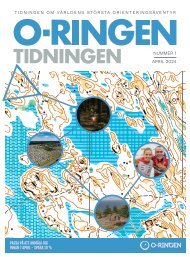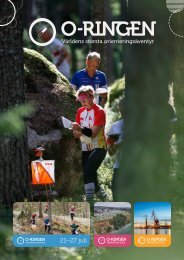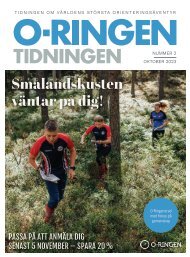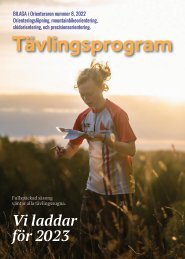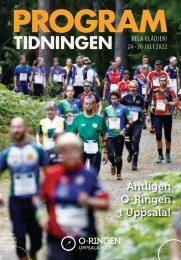O-Ringen Magazine, nr 1 2024
The worlds biggest orienteering adventure. Oskarshamn, Smålandskusten, July 21st to 27 th 2024.
The worlds biggest orienteering adventure. Oskarshamn, Smålandskusten, July 21st to 27 th 2024.
Create successful ePaper yourself
Turn your PDF publications into a flip-book with our unique Google optimized e-Paper software.
Learn to save lives!<br />
Read and learn more<br />
What to do if you suspect cardiac arrest<br />
Sudden cardiac arrest is a life-threatening condition where<br />
the heart, for whatever reason, stops beating. It’s more<br />
common than you might realise. Many people believe it only<br />
affects the elderly, which isn’t true. Sudden cardiac arrest<br />
can affect people of all ages.<br />
Every day, around 16 Swedes suffer cardiac arrest outside of<br />
hospital, requiring cardiopulmonary resuscitation (CPR). Only<br />
two of these survive. Not everyone can be saved but, with the right<br />
knowledge and equipment in place, many more could be.<br />
The most important thing is for CPR to start immediately and<br />
that a defibrillator is available and ready to use. The chances of<br />
survival decrease by 10% with every passing minute, so there really<br />
is no time to lose.<br />
When someone phones 112 to report a cardiac arrest, SOS<br />
Alarm are alerted – as well as the emergency services, up to 30<br />
citizen responders will receive information by text about where the<br />
nearest defibrillator is.<br />
It is also very important that defibrillators are registered (www.<br />
hjartstartarregistret.se) and ideally, are available to use all the<br />
time. It’s great that there are so many defibrillators but they need<br />
to be available, not behind locked doors. In Sweden, only 20% of<br />
Stefan Jutterdal survived a cardiac arrest himself and is now an ambassador for Hjärtuppropet. Photo: Hjärtuppropet.se<br />
defibrillators are available all the time. In Denmark it’s 70% and the<br />
chances of survival there are significantly higher.<br />
What can we do to make our society safer for hearts?<br />
Ahead of this summer’s O-<strong>Ringen</strong> on the Småland Coast, we<br />
are taking the initiative to work towards a safer place for hearts,<br />
working alongside Hjärtuppropet, Kalmar region and the Swedish<br />
Heart and Lung Association in Oskarshamn.<br />
The message is that more lives could be saved if everyone learns<br />
how to do CPR and there are enough defibrillators available. So,<br />
everyone who has a defibrillator is urged to make sure it’s registered<br />
and, if possible, place it in a heated box outside. This would help<br />
make Kalmar region a safer place for hearts. The initiative has been<br />
well received and so far nine defibrillators have been moved outside,<br />
making them available at all hours.<br />
The housing association Byggebo AB, Döderhult parish, IK Oskarshamn<br />
and Oskarshamn District Council have all led by example<br />
and hopefully the number of defibrillators available all the time will<br />
increase over the spring.<br />
Residents are also encouraged to attend a CPR course. A good<br />
start is the Swedish Heart and Lung Association’s new online course<br />
at hlr.nu/allakanhlr/, which takes only 15 minutes.<br />
Defibrillator register<br />
hjartstartarregister.se<br />
Find your nearest defibrillator<br />
“allakanHLR” (everyone can do CPR)<br />
hlr.nu/allakanhlr<br />
The Swedish Heart and Lung<br />
Association’s new online course,<br />
which takes only 15 minutes<br />
How to perform CPR on adults<br />
hlr.nu/sa-har-gor-du-vuxen-hlr/<br />
CPR advice in Swedish<br />
What is his advice on how we can improve cardiac safety?<br />
– Everyone should know how to do CPR. It’s just as important as<br />
being able to swim. Learn CPR and become a citizen responder.<br />
We also need more defibrillators to be available. Go to hjartstartarregistret.se<br />
to see where your nearest defibrillator is!<br />
You can help to save lives!!<br />
Anders Strömbäck is the project manager for O-<strong>Ringen</strong> <strong>2024</strong>. He is<br />
working to make sure all control guards out in the terrain have had<br />
CPR training, which means 400-500 volunteer officials will have<br />
attended CPR courses this spring in<br />
preparation for O-<strong>Ringen</strong>.<br />
– There will be over 20 defibrillators<br />
available during O-<strong>Ringen</strong> week, so<br />
we’re doing what we can to ensure<br />
a safe environment for hearts, says<br />
Anders Strömbäck.<br />
Stefan Jutterdal with a defibrillator Photo: hjartuppropet.se<br />
1. Check consciousness<br />
Take hold of the person’s shoulders, shake gently and<br />
try to wake them. Shout “Hello, are you awake?” If<br />
there is no response, check breathing.<br />
2. Check breathing<br />
Check if the person is breathing normally. Open their<br />
airway by putting one hand on their forehead, tilting<br />
their head backwards and lifting their chin with the<br />
other hand, with two fingers under the chin. Put your<br />
ear to the person’s nose and mouth, listen for breathing<br />
and check if their chest is rising and falling. If<br />
the person has abnormal breathing or isn’t breathing<br />
at all (or if you’re not sure), assume it’s a cardiac<br />
arrest..<br />
3. Phone 112<br />
If the person is unconscious and not breathing normally/at<br />
all, alert 112 using speakerphone. The operator will<br />
help you perform CPR. Start with 30 chest compressions,<br />
followed by two breaths.<br />
4. Perform chest compressions<br />
Place the heel of your hand in the middle of the chest<br />
and put your other hand over it. Interlace your fingers.<br />
With straight arms, push down at least 5 cm on the<br />
chest, but not more than 6 cm. Repeat 30 times at a<br />
rate of 100-120 compressions per minute.<br />
5. Give breaths<br />
Open the airway: lift the chin and tilt the head back.<br />
Put one hand on the forehead, tilt the head back and<br />
lift the chin with the first two fingers of the other hand.<br />
Pinch the person’s nose, open your mouth wide so you<br />
take the whole of their mouth in yours and blow in<br />
air until their chest rises. Perform two breaths. If you<br />
cannot or don’t want to do this, it’s better to perform<br />
only chest compressions than to do nothing. Chest<br />
compressions alone can be very effective, especially<br />
during the first minutes..<br />
6. Repeat steps 4 and 5<br />
Continue these steps until the emergency services arrive<br />
and take over, or the person is breathing normally.<br />
Minimise any breaks in CPR.<br />
7. Fetch a defibrillator<br />
If there are several responders working together, one<br />
should begin CPR and another should phone 112 and<br />
then fetch the nearest defibrillator. Connect it and follow<br />
the spoken instructions. You can find your nearest<br />
defibrillator at hjartstartarregistret.se<br />
64 O-RINGEN MAGAZINE NO. 1 • <strong>2024</strong> O-RINGEN MAGAZINE NO. 1 • <strong>2024</strong> 65





